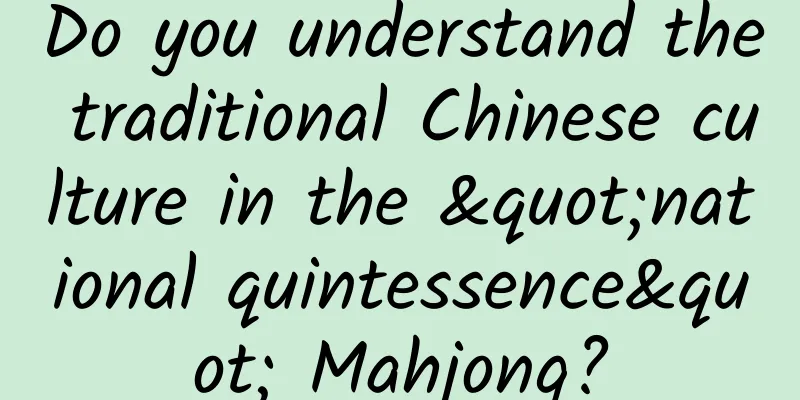Do you understand the traditional Chinese culture in the "national quintessence" Mahjong?

|
When friends and family get together during the Spring Festival, I believe many people’s first choice is to play mahjong . Before the New Year, there was a piece of news that became a hot topic: "The Xi'an Bureau of the National Railways launched a customized train with the theme of "Qinling Ice and Snow Tour", which included a special carriage equipped with mahjong machines." Sitting on the train and playing mahjong attracted great attention from netizens. The picture comes from the Internet As a quasi-national treasure of China, when did mahjong appear? In fact, it is not as long ago as we think. Through various expert arguments and folk sayings, the time that can be traced back is basically to the Ming and Qing Dynasties . Let me tell you about several popular sayings below. 01 The legend of the origin of Mahjong 1. Taicang Sparrow Theory According to legend, there was a royal granary in Taicang that stored rice. Due to the constant infestation of sparrows, the granary supervisor made bamboo chips to count the number of sparrows hit by the soldiers in order to encourage them to catch sparrows. Later, it gradually evolved into a form of entertainment, which is now known as mahjong. The original form of mahjong was also called "playing sparrow". 2. Ningbo Chenyumen Mahjong Chen Yumen, courtesy name Zhengyao, was a third-rank official during the Tongzhi and Guangxu periods of the Qing Dynasty, and a native of Ningbo, Zhejiang. According to legend, Chen Yumen created a new way of playing mahjong based on the basic suits and forms of Majiang and Yezige. He had a good relationship with the British Consul in Ningbo, Xia Fuli, and taught the British how to play mahjong. Chen Yumen also created new rules such as "gang", "chi" and using dice for positioning, and then mahjong spread from Ningbo to all parts of the country. Copyright image, no permission to reprint 3. Wan Bingtiao created Mahjong According to legend, Wan Bingtiao, a Ming Dynasty writer, created 108 mahjong tiles based on the images of the 108 heroes in "Water Margin" because he loved the heroes in the book. For example, Jiutiao is a metaphor for Shi Jin, the "Nine-Pattern Dragon", and Yibing is Li Kui, the "Black Whirlwind". These heroes come from all directions, so there are four sets of cards: "East, South, West, and North". The heroes who gathered at Liangshan are rich and poor, and have different backgrounds, so there are three sets of cards: "Zhong, Fa, and Bai". Zhong represents the middle-class family, Fa is the rich family, and Bai refers to the common people and the poor. The inventor designed the remaining three sets of cards, namely "Wan", "Bing" (called "Tong" in the south) and "Tiao" (called "Suo" in the south), based on the homophony of his own name, Wan Bingtiao. This statement lacks empirical evidence and is considered a folk legend, but it still sounds very interesting. 4. Zheng He invented Mahjong during his voyages to the West It is said that in order to enable his crew to survive the long voyage, Zheng He made more than a hundred small pieces of wood as game tools using the bamboo on the ship. The game tools are set up according to the fleet organization and the number of fresh water barrels on the ship, with one to nine lines and one to nine barrels (tubes) engraved respectively. East, west, south, north and four flower cards are engraved according to the wind direction and the four seasons of the year. One to ninety thousand are engraved as game chips. Zhong represents the Chinese land; Fa represents getting rich; Bai represents daytime. After this deck of cards was created, all the crew members started playing it. One of the generals, whose surname was Ma, was particularly good at it. So Zheng He named this deck of cards "General Ma", which was later also called Mahjong. From the above theories of origin, we can see that mahjong should have first become popular in the coastal areas of Jiangsu and Zhejiang. Combined with the different dialects in different regions and the different living and working habits, the mahjong rules in different places are also different. There are Fujian mahjong, Jiangsu mahjong, Hebei mahjong, Sichuan mahjong, Guangdong mahjong, etc. There are many terms for different combinations of card types and ways of (winning, making a sound, and making a Hu): "Big Four of Happiness", "Big Three of Yuan", "Small Three of Yuan", "Mixed One Color", "All One Color", "One Dragon", "Thirteen No Support", etc. Four players are equal when playing cards. Through everyone's overall coordination, the thirteen cards in their hands show rich arrangements and combinations, fun and technical skills. Combined with the randomness of each round, it becomes an easy-to-play and interesting chess and card game. Tracing back to the mahjong card types and playing rules, we can see the presence of dominoes and Majiang. Mahjong is also a type of domino game, in which cards and dice are used in conjunction with each other. The earliest dice in ancient China had eighteen sides, and it was not until the Tang Dynasty that they were finalized into the six-sided cube that we commonly see today. The Mahjong tiles also borrowed from another type of dominoes, Pai Gow. However, the basic rules of Mahjong are derived from Ma Diao, a leaf-shaped tile that became popular in the Ming Dynasty. As a card game, Majiang consists of 40 cards in a deck. The dealer is chosen by rolling the dice. There are pictures of Water Margin characters on the cards, and four players compete in a round. The specific playing method was lost during the Kangxi period of the Qing Dynasty. Majiang brand. The picture comes from the Internet The common mahjong we have now is generally divided into two types: One is the 136-tile Mahjong popular in northern China and Sichuan . The tiles are divided into three gates: Wan, Bing, and Tiao. Each gate has four tiles from one to nine. There are also four tiles each for Zhong, Fa, Bai, Dong, Nan, Xi, and Bei, for a total of 136 tiles. The other is Fujian Mahjong , which adds eight more flower cards: Spring, Summer, Autumn, Winter, Plum, Orchid, Bamboo and Chrysanthemum, for a total of 144 cards. Flower cards. Image from the Internet Anyone who has a little knowledge of traditional Chinese culture knows that the flower cards shown here actually represent the four seasons of spring, summer, autumn and winter respectively, and they also represent excellent personality traits, and are known as the Four Gentlemen. The addition of eight flower cards also incorporates the idea of "harmony between man and nature" in traditional Chinese culture, which is the harmonious coexistence of nature and humans, into the game, reflecting the yearning for a better life. In the game of Mahjong, everyone is equal, and they both check and balance each other and develop independently, over and over again, maintaining a balanced relationship. Therefore, Mahjong has also become a social tool in Chinese society. Whether it is old friends or relatives whom you haven't seen for a long time, or new friends you just met, after a few rounds of mahjong, you can quickly become familiar with each other through mahjong-related topics. 02 Mahjong and "Gambling" Mahjong, as a board game, also has its two sides. Since its birth, it has been inevitably associated with gambling. After the founding of New China, an extremely strict management system was once adopted for mahjong. In 1985, the Ministry of Public Security issued a notice on "the public security organs no longer interfering in the manufacture and sale of mahjong and playing cards". The notice stated that "although mahjong and playing cards can be easily used for gambling, they are also traditional entertainment tools in my country. We must strictly prohibit gambling, but we do not need to ban playing cards." Copyright image, no permission to reprint Is playing mahjong gambling? The two words "gambling" have different meanings. Gambling means to bet money and property to win or lose. "Shuowen" has "博簺也". "簺" (pronounced "sai"), also known as " gewu ", refers to a chess game popular in China from the Han Dynasty to the Northern and Southern Dynasties. Gambling has existed since ancient times. The allusion of "betting on a villa by playing Go" comes from "Book of Jin·Biography of Xie An", "An then ordered his carriage to go out to his villa in the mountain, where all his relatives and friends gathered, and then he played Go and bet on a villa with Xuan." Among its many meanings, "Bo" also includes an ancient chess game called " Boxi " or "Liubo". In 2019, more than 1,000 bamboo slips containing the chess score of "Liubo" were found among the bamboo slips unearthed from the tomb of Marquis Haihun in Jiangxi Province. Image source: Official Weibo of Nanchang Han Dynasty Haihunhou State Ruins Management Bureau Liubo became popular as early as the pre-Qin period. It is said to have originated in the Xia Dynasty. It was created by a man named Wu Cao during the reign of King Jie of Xia. It includes sticks, dice, chess pieces, etc. Xue Xiaotong of the Northern Wei Dynasty wrote in his book "Liubo": "Wucao invented Liubo, and its origin is very ancient." Bo was once very popular in Chinese history, especially during the Han Dynasty. According to historical records, Emperor Wen, Emperor Jing, Emperor Wu, Emperor Zhao, and Emperor Xuan of the Han Dynasty all loved playing Liubo chess, and a special official position of "Bo Dai Zhao" was set up to accompany the emperor in playing chess. People who were good at Bo enjoyed a high status and were respected in society at that time. Today we can see a large number of objects and images related to Liubo chess from the unearthed cultural relics from the Han Dynasty. Image source: Official Weibo of Nanchang Han Dynasty Haihunhou State Ruins Management Bureau From this, we can see that gambling was originally an activity to obtain material or benefits through games such as chess, cards, and dice. Mahjong is given its purpose and meaning by people, not by itself. Chairman Mao once said: "China's three major contributions to the world are: the first is Chinese medicine, the second is Cao Xueqin's Dream of the Red Chamber, and the third is mahjong." Mahjong is the most popular board game in China over the past century. As a folk game, it is widely spread and popular. It is not only popular in China, but also spread to Japan, the United States, the Netherlands, Denmark, Southeast Asia and some countries and regions in Europe, becoming one of the most popular board games in the world. The biggest regret in life is missing one of the three, so what are you waiting for. References: [1] Yang Jingqian. A Study on the Origin and Development of Mahjong: From the Original Form of Entertainment to the Pseudo-Form of Burden[D]. Yunnan University, 2011. [2] Zhang Lifang. Problems and countermeasures of the overseas dissemination of Chinese Mahjong culture[D]. Nanchang University. [3] Tang Xiaojie. Interpreting the cultural characteristics of mahjong graphic symbols from the perspective of graphic narrative [D]. Jiangxi Normal University. [4] Zhou Haixiong, Wang Yanling. The origin and evolution of Mahjong[J]. Journal of Ningbo University: Humanities Edition, 2002, 15(4):3. [5] Bao Zhanbin. Philosophical thinking on the protection of controversial intangible cultural heritage: Taking mahjong culture as an example [J]. Journal of Ningbo University: Humanities Edition, 2017, 30(2):6. [6] Guan Li, Yang Jun, Wang Yile, et al. Bamboo slips unearthed from the tomb of Liu He, Marquis of Haihun of the Western Han Dynasty in Nanchang, Jiangxi Province [J]. Cultural Relics, 2018(11):10. Author: Wang Youmei, Researcher of Cultural History of Luoyang Cultural Protection Group, former Deputy Director of the Education Department of Luoyang Museum The cover image and some images in this article are from the copyright library Reproduction of image content is not authorized |
<<: Why is there a ball on the roof? So many people don't know
Recommend
60% of short video ads are allocated to mid-level anchors. Are top anchors no longer popular?
These two days, I saw a short video KOL marketing...
Mobile Development Guide: Introduction to Android Transition Framework
【51CTO translation】The Android Transition framewo...
How to improve the conversion rate of the lead generation training camp?
The following is a review of a recently concluded...
Lisa was sued by US stock investors and laid off 18% of her employees. Ideal's recent situation is not so "ideal".
Do you remember the Ideal MEGA incident some time...
APP promotion: Where do new users come from and how to acquire them?
A store without customers will close, and a produ...
Should you keep your electric water heater on all the time? Or should you only turn it on when you need it? Read on to find out →
Note: The cover image is a copyrighted image. Rep...
The “unspoken rules” of short video operation and creation!
With the development of the economy, people's...
The pilot's last patron saint - ejection life-saving system
The movie "Lord of the Skies" depicts t...
Today's headlines are actually fighting against themselves
The strictest rectification in history is here, an...
Someone was defrauded of 100,000 yuan! Be sure to be vigilant against these scams on "Double Eleven"!
It's time again The annual shopping season Th...
How significant is the successful induction of pluripotent stem cells using drugs?
Recently, Ding Sheng, Liu Kang and Ma Tianhua fro...
Weibo released its 2019 annual financial report, with annual financial revenue reaching 12.24 billion yuan
Recently, Weibo released its full-year and fourth...
Will Apple's iPhone fall behind in the 5G era? Self-developed, Intel is unreliable, Samsung and Qualcomm refuse to sell
There is no doubt that 5G mobile phones will be l...
Using data from 41 solar occultations, the mystery of Saturn's rings was finally discovered?
Sun reveals secrets of Saturn's rings Saturn&...
How can a WeChat public account quickly increase its followers from “0” to “1000” in a single day?
Increasing fans of public accounts has always bee...









